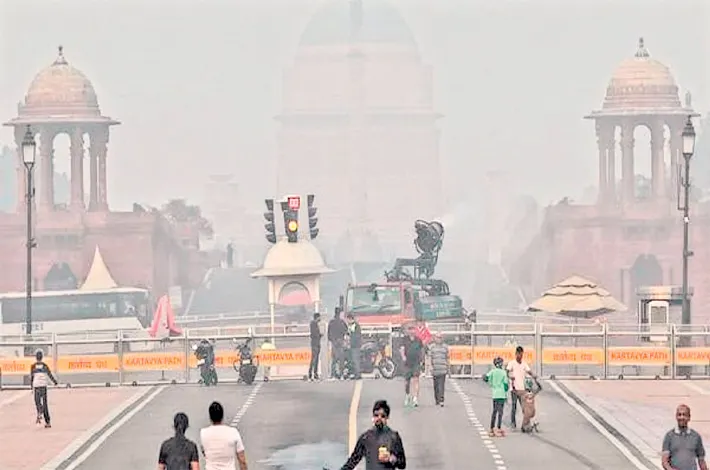Living in Delhi ? You are smoking 10 cigarattes a day !
10-11-2025 12:00:00 AM

■ Experts warnthat breathing polluted air in Delhi is equivalent to smoking nearly 10 cigarettes a day.
■ Every microgram of polluted air adds 12,000 premature deaths annually in India, with a 35% PM 2.5(Particulate Matter) increase linked to 24% higher mortality risk.
■ For immediate public action, medical experts suggested staggering work timings, ending littering and open garbage dumps, fully tarring roads and modern cleaning over brooming.
■ Measures like GRAP-1 and GRAP-2or failed cloud seeding wasting crores, fall short without stricter implementation and better urban planning.
■ Proposed solution for farm fires includes direct push for organic farming, pilot projects with income support for ecological services and discouraging paddy.
The National Capital Region (NCR) is gasping for breath as India's air quality plunged to hazardous levels, with the overall Air Quality Index (AQI) recorded at 654. Experts have warned that breathing this polluted air is equivalent to smoking nearly 10 cigarettes a day. The city has been grappling with deteriorating conditions since Diwali, exacerbated by post-festival pollution, smoke from farm fires in neighboring states like Punjab, and low wind speeds trapping pollutants over the capital.
Surrounding areas fared no better—NOIDA logged an AQI over 700 early in the morning, while Gurugram settled at 401, firmly in the unhealthy category. Authorities advise residents to avoid outdoor exercise and commuting during peak pollution hours, recommending N95 masks outdoors and air purifiers indoors to minimize exposure to fine particulate matter. Clean air is not a privilege for the few but a fundamental right for all.
The pressing question is no longer who caused this crisis but what can be done to end it. A reputed nephrologist described it as a "complete holistic catastrophe," no longer hideable. He highlighted its year-round impact, damaging pregnancies, fetal chromosomes, and future generations. Published data reveals over 3 million pollution-related deaths in India annually—equivalent to multiple COVID Delta waves every year. This stems from political failure in enforcing strong will, citizen inaction in raising voices, and a call for Supreme Court intervention as a public health emergency.
Another famous pediatrician emphasized underestimation in AQI readings by 20-25% due to the hygroscopic nature of various types of particulate matter clustering together. At AQI 500, it's akin to 9-10 cigarettes daily; levels often exceed 999 or even 1,000 at night amid fog and humidity, equating to 9,000 cigarettes over five winter months. Every microgram of polluted air adds 12,000 premature deaths annually in India, with a 35% PM 2.5(Particulate Matter) increase linked to 24% higher mortality risk.
Beyond particulates, micro-nanoplastics and heavy metals create a "Trojan horse" effect, magnifying damage, blunting immunityand causing carcinogens. Impacts span every organ—respiratory, heart, brain, bones, fetuses—leading to obesity, diabetes, hypertension, strokes, and DNA impairment. "We are sitting ducks to a host of diseases," medical experts warned, urging iron-fisted measures: timed no-car zones, complete farm fire bans across states, and strict construction controls.
A senior journalist pointed out the annual recurrence, worsened by stubble burning and weather inversions trapping pollutants over Delhi-NCR. Politicians and the Supreme Court appear reluctant to act, despite constants like vehicular traffic, construction dust, and small fires. "The political will to stop it is simply not there," he said, dismissing vehicular pollution and dust as primary culprits in winter—the real drivers are farm fires combined with inversion. Measures like GRAP-1 and GRAP-2, or failed cloud seeding wasting crores, fall short without stricter implementation and better urban planning.
An agri policy expert labelled it an "absolute failure in thought," with government inaction directly correlating to more toxic smoke inhaled yearly. On farm fires he proposed solutions solvable in two years: direct push for organic farming, pilot projects in 6% of Punjab villages impacting Delhi with income support for ecological services, discouraging paddy. He pointed out that farmers in Punjab also design affordable machines via Punjab Agricultural University or direct bank transfers to local workers for stubble removal. He also called for addressing green revolution varieties forcing burns, reviving cattle sectors to consume straw and curb politicization and corruption profiting from persistence.
For immediate public action, medical experts suggested staggering work timings, ending littering and open garbage dumps, fully tarring roads and modern cleaning over brooming. Digitally track vehicle pollution, enforce no-car zones in congested areas. They pointed out that children suffer most—breathing twice adults' rate, with underdeveloped immunity—impacting growth; advocate hybrid school models despite disruptions.
They also called for a dedicated air pollution ministry with scientists, environmentalists, and doctors, plus enforceable laws—over 200-300 farm fires in the last month is "not fair." The crisis is man-made and solvable—not seasonal inconvenience but systemic challenge. Delhi's smoke reminds us of choices made and those ahead. Real progress demands collaboration, not blame. Let's hope future discussions measure cleaner skies, not dread AQI readings.








